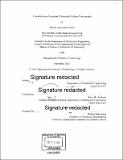Towards force-correlated ultrasound volume elastography
Author(s)
Graule, Moritz Alexander
DownloadFull printable version (9.500Mb)
Other Contributors
Massachusetts Institute of Technology. Department of Mechanical Engineering.
Advisor
Brian W. Anthony.
Terms of use
Metadata
Show full item recordAbstract
This thesis proposes three ultrasound-based methods that enable quantification of tissue and organ properties with potential applications as non-invasive, image-based biomarkers: force-controlled elasticity quantification for the identification of strain hardening; registration and segmentation of B-mode images to measure organ volumes; and force-correlated three-dimensional elasticity maps. In order to allow for the simultaneous collection of tissue elasticity and compressive force, a shear wave elasticity enabled ultrasound probe was integrated with a load cell which measured the sonographer-applied preload. The device was used to demonstrate the strong preload dependence of elasticity in ex-vivo bovine liver, illustrating the importance of accounting for preload when using elastography to assess tissue health. Finally, this device enables the quantification of strain hardening as an additional metric for tissue health. The capability organ volume measurements through freehand ultrasound imaging was demonstrated in a clinical study in which kidney volumes were obtained from ultrasound sweeps and compared to ground truth data from CT scans. While the technology needs to be refined to achieve better agreement between the measured volumes, the initial results of this ongoing study allowed for the identification of an ideal acquisition strategy. These findings will inform future data collection to achieve an improved accuracy. The acquisition of three-dimensional force-correlated elasticity maps was demonstrated on a phantom with the successful detection of a high-stiffness lesion embedded in bulk material. The presented technology has the potential to be a quantitative replacement for manual palpation. Given further refinement, this technology could be used to replace needle biopsy in various diseases in which progression correlates with tissue stiffness, such as thyroid nodules or liver fibrosis and cirrhosis. Our method, unlike the inherently localized needle biopsy, allows for the assessment of tissue over a broad volume, potentially improving reliability and repeatability in diagnosing and staging diffuse diseases.
Description
Thesis: S.M., Massachusetts Institute of Technology, Department of Mechanical Engineering, 2017. Cataloged from PDF version of thesis. Includes bibliographical references (pages 58-67).
Date issued
2017Department
Massachusetts Institute of Technology. Department of Mechanical EngineeringPublisher
Massachusetts Institute of Technology
Keywords
Mechanical Engineering.